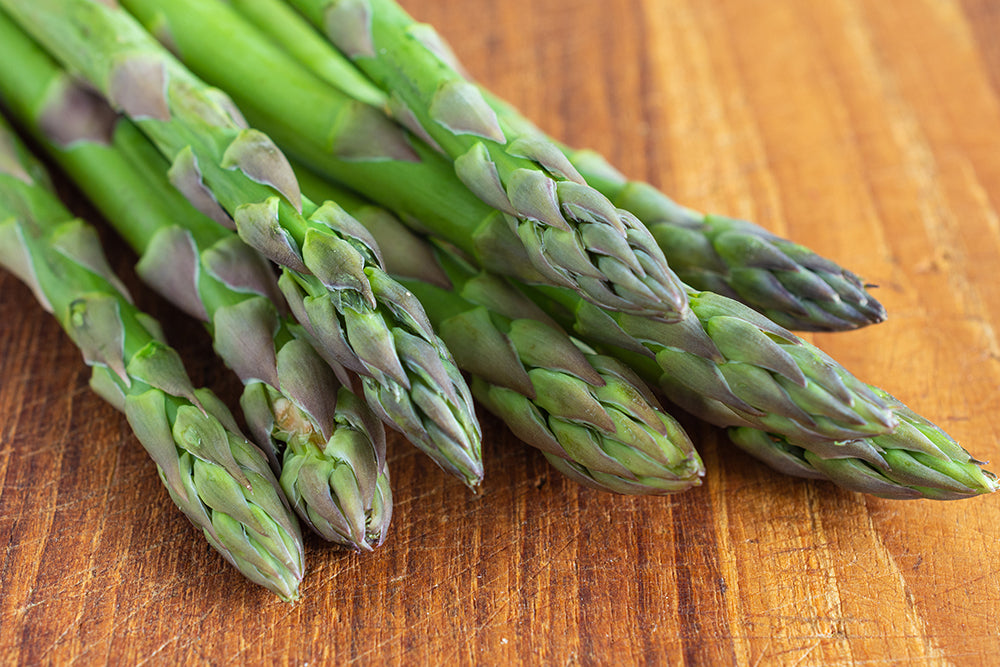
Growing Asparagus from Seed or Crowns (Roots)
Asparagus lovers, rejoice! This spring crop is delicious, nutritious, easy to grow, and a single planting can yield harvests for 15 to 20 years! Growing asparagus in our area takes some planning and cultivation, but these vegetables are the “crown” of any spring garden.
According to experts, asparagus grows best in loose, lighter soils that warm up quickly and drain well. Since standing water can rot the roots of this perennial, raised beds are most successful for planting. Some folks like to plant asparagus from “crowns,” the roots of a parent asparagus plant. Others prefer to start asparagus from seed in an indoor setting. Either way, it takes a few years and some cultivation for the perfect asparagus crop. Whether you opt to plant crowns or start from seed, the pros at Rohrer Seeds can answer your questions and have the supplies you need.
Planting and Caring for Asparagus Gardens
Asparagus plants are either male or female. Male plants produce more harvestable stalks and there are some varieties that are all male, thus ensuring higher yields and less gardening work. If starting from seed, it takes a few years before crops should be harvested. It takes about two years after the plants are in a permanent bed for them to establish strong, deep root systems and produce a bountiful crop. Some people feel that the extra year of starting from seeds and planting seedlings after they are a foot high, are worth the extra effort. But planting asparagus crowns from a reputable supplier like Rohrer Seeds gets you harvesting these veggies a year sooner. Whichever way you choose to start your asparagus, Rohrer Seeds has tips and advice to grow a delicious and bountiful asparagus crop.
Asparagus needs rich soil that drains well, then seedlings should be placed one to two inches deep in the raised bed. Asparagus crowns should be planted deeper – about 6 inches – and soaked in compost tea for about 20 minutes before planting, to strengthen the root system. (A compost tea is made up of composted materials soaked in water – like loose tea in a teapot.) As the soil in the raised garden bed settles, another inch or so of soil should be added around the base of each plant every few weeks until soil looks slightly mounded above the surface. This strengthens the base and protects the root systems of these plants. Keep weeding and watering regularly and add compost tea or a basic balanced fertilizer along the sides of the rows. Mulch can help tamp down weeds and fertilizing will help these perennials thrive.
After spring harvest, it is best to leave asparagus stems on the plants until they start to turn brown and brittle (usually in late fall). Then cut off the stalks and ferns at ground level, covering the garden with a protective layer of compost or manure. Remember to place these brown stalks and ferns in the trash (do NOT mulch these dead stalks) and make sure to trim any stray fern-like foliage from the plants at the end of each winter, before new spring growth starts. This will make sure the any eggs or larvae of harmful pests do not impact the spring crop.
Harvesting and Storing Asparagus
Although it takes a few years for asparagus plants to be harvestable, once planted, you will have a bountiful springtime crop for years to come. Asparagus spears can be harvested with a sharp knife or snapped off at ground level just by using your fingers. Be careful not to pull at the roots. In early spring, gather asparagus every third day; as weather warms, though, this vegetable may yield even more spears and need to be harvested twice a day. But the growing season is only 6-8 weeks, so gather what you can.
Asparagus spears can be kept in the refrigerator for a little over a week if you keep the bottoms trimmed and in water. (Change the water if it gets cloudy.) For longer asparagus storage, blanch the spears for two to four minutes in boiling water, drain, pat dry, and freeze. Once frozen, store in a container or plastic bag until ready to use. While this vegetable is full of vitamins, antioxidants and is low in calories, it is also delicious slathered in butter, roasted with sea salt and olive oil, drizzled with cheese, and added to salads!




Comments
Leave a comment